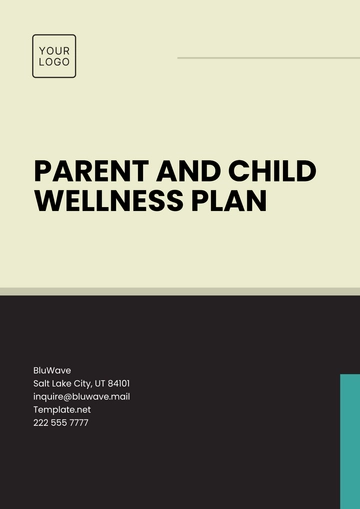Free Physical Wellness Plan

Prepared by: [Your Name]
Company: [Your Company Name]
Date: [Insert Date]
I. Introduction
Physical wellness is the cornerstone of a healthy and balanced life. It involves adopting habits and practices that enhance physical fitness, prevent health issues, and promote overall vitality. This Physical Wellness Plan provides a structured approach to improving physical health through targeted strategies and resources, ensuring participants can achieve their wellness goals and maintain an active lifestyle.
II. Vision and Goals
Vision:
To foster a culture of health and fitness where individuals feel empowered to prioritize their physical well-being and adopt sustainable healthy habits.
Goals:
Promote regular physical activity.
Encourage nutritious eating habits.
Prevent physical strain and injury.
Improve overall health metrics, such as energy levels and fitness.
III. Key Strategies and Initiatives
A. Fitness Activities
Weekly Group Fitness Sessions: Offer activities such as yoga, Zumba, strength training, and walking clubs to promote regular exercise and camaraderie.
Fitness Challenges: Organize monthly challenges like step-count competitions or "miles walked" goals to encourage movement.
Gym Partnerships: Partner with local fitness centers to provide discounted memberships for participants.
B. Nutrition Support
Healthy Food Options: Provide nutritious snacks in shared spaces, such as fruits, nuts, and protein bars.
Meal Prep Workshops: Host healthy cooking, meal planning, and nutrition education workshops.
Water Stations: Ensure easy access to filtered water with hydration stations in common areas.
C. Workplace Ergonomics
Ergonomic Workstations: Equip workspaces with adjustable chairs and standing desks, and monitor risers to minimize physical strain.
Stretch Breaks: Encourage short stretching routines throughout the day to alleviate tension and improve posture.
D. Preventive Health Measures
Annual Health Screenings: Provide access to yearly health check-ups, including blood pressure, cholesterol, and BMI monitoring.
Vaccination Drives: Organize flu shots and other preventive vaccination programs.
First Aid Training: Offer basic first aid and CPR training for participants.
E. Outdoor Engagement
Community Walks or Runs: Host quarterly outdoor events, such as 5K runs or nature walks, to promote physical activity and community bonding.
Recreational Sports Teams: Form teams for sports like soccer, basketball, or volleyball to encourage regular physical activity.
F. Awareness Campaigns
Physical Wellness Education: Share resources through newsletters, webinars, or posters on topics like exercise benefits, injury prevention, and stretching techniques.
Health Challenges: Create awareness weeks focused on fitness, nutrition, or overall wellness.
IV. Implementation Plan
Roles and Responsibilities:
Wellness Coordinator: Oversee the development and execution of physical wellness programs.
Participants: Actively engage in activities, provide feedback, and adopt suggested practices.
Leadership Team: Allocate resources and promote the importance of physical wellness within the organization.
Timeline:
Phase 1 (Months 1–2): Assess participant needs and finalize program details.
Phase 2 (Months 3–6): Launch initial programs, such as group fitness sessions and ergonomic improvements.
Phase 3 (Months 7–12): Expand initiatives and evaluate impact through feedback and participation metrics.
V. Measurement and Evaluation
Key Performance Indicators (KPIs):
Participation rates in fitness and wellness programs.
Feedback on program effectiveness and satisfaction.
Improvements in health metrics (e.g., fitness test results, self-reported energy levels).
Evaluation Methods:
Conduct quarterly surveys to gather feedback and identify areas for improvement.
Track attendance at fitness sessions and health screenings.
Prepare an annual wellness report summarizing successes, challenges, and future goals.
VI. Sustainability Plan
Secure funding for ongoing activities through sponsorships or partnerships.
Rotate wellness committee members to bring fresh perspectives to the program.
Introduce a digital platform or app to streamline program information and scheduling.
Regularly update initiatives based on participant needs and emerging health trends.
VII. Conclusion
This Physical Wellness Plan offers a comprehensive approach to fostering a healthier and more active lifestyle. Incorporating regular fitness activities, nutritional support, ergonomic practices, and preventive measures, empowers participants to take charge of their physical well-being.
Through sustained efforts, collaboration, and a commitment to continuous improvement, this plan seeks to enhance physical health, boost energy levels, and build a vibrant community dedicated to wellness.
- 100% Customizable, free editor
- Access 1 Million+ Templates, photo’s & graphics
- Download or share as a template
- Click and replace photos, graphics, text, backgrounds
- Resize, crop, AI write & more
- Access advanced editor
You may also like
- Finance Plan
- Construction Plan
- Sales Plan
- Development Plan
- Career Plan
- Budget Plan
- HR Plan
- Education Plan
- Transition Plan
- Work Plan
- Training Plan
- Communication Plan
- Operation Plan
- Health And Safety Plan
- Strategy Plan
- Professional Development Plan
- Advertising Plan
- Risk Management Plan
- Restaurant Plan
- School Plan
- Nursing Home Patient Care Plan
- Nursing Care Plan
- Plan Event
- Startup Plan
- Social Media Plan
- Staffing Plan
- Annual Plan
- Content Plan
- Payment Plan
- Implementation Plan
- Hotel Plan
- Workout Plan
- Accounting Plan
- Campaign Plan
- Essay Plan
- 30 60 90 Day Plan
- Research Plan
- Recruitment Plan
- 90 Day Plan
- Quarterly Plan
- Emergency Plan
- 5 Year Plan
- Gym Plan
- Personal Plan
- IT and Software Plan
- Treatment Plan
- Real Estate Plan
- Law Firm Plan
- Healthcare Plan
- Improvement Plan
- Media Plan
- 5 Year Business Plan
- Learning Plan
- Marketing Campaign Plan
- Travel Agency Plan
- Cleaning Services Plan
- Interior Design Plan
- Performance Plan
- PR Plan
- Birth Plan
- Life Plan
- SEO Plan
- Disaster Recovery Plan
- Continuity Plan
- Launch Plan
- Legal Plan
- Behavior Plan
- Performance Improvement Plan
- Salon Plan
- Security Plan
- Security Management Plan
- Employee Development Plan
- Quality Plan
- Service Improvement Plan
- Growth Plan
- Incident Response Plan
- Basketball Plan
- Emergency Action Plan
- Product Launch Plan
- Spa Plan
- Employee Training Plan
- Data Analysis Plan
- Employee Action Plan
- Territory Plan
- Audit Plan
- Classroom Plan
- Activity Plan
- Parenting Plan
- Care Plan
- Project Execution Plan
- Exercise Plan
- Internship Plan
- Software Development Plan
- Continuous Improvement Plan
- Leave Plan
- 90 Day Sales Plan
- Advertising Agency Plan
- Employee Transition Plan
- Smart Action Plan
- Workplace Safety Plan
- Behavior Change Plan
- Contingency Plan
- Continuity of Operations Plan
- Health Plan
- Quality Control Plan
- Self Plan
- Sports Development Plan
- Change Management Plan
- Ecommerce Plan
- Personal Financial Plan
- Process Improvement Plan
- 30-60-90 Day Sales Plan
- Crisis Management Plan
- Engagement Plan
- Execution Plan
- Pandemic Plan
- Quality Assurance Plan
- Service Continuity Plan
- Agile Project Plan
- Fundraising Plan
- Job Transition Plan
- Asset Maintenance Plan
- Maintenance Plan
- Software Test Plan
- Staff Training and Development Plan
- 3 Year Plan
- Brand Activation Plan
- Release Plan
- Resource Plan
- Risk Mitigation Plan
- Teacher Plan
- 30 60 90 Day Plan for New Manager
- Food Safety Plan
- Food Truck Plan
- Hiring Plan
- Quality Management Plan
- Wellness Plan
- Behavior Intervention Plan
- Bonus Plan
- Investment Plan
- Maternity Leave Plan
- Pandemic Response Plan
- Succession Planning
- Coaching Plan
- Configuration Management Plan
- Remote Work Plan
- Self Care Plan
- Teaching Plan
- 100-Day Plan
- HACCP Plan
- Student Plan
- Sustainability Plan
- 30 60 90 Day Plan for Interview
- Access Plan
- Site Specific Safety Plan





























